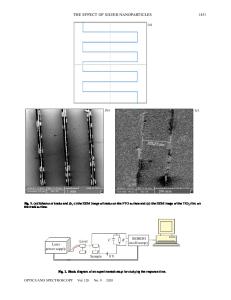The Unique Electronic Properties of the Silver Halides
- PDF / 711,919 Bytes
- 6 Pages / 604.8 x 806.4 pts Page_size
- 88 Downloads / 316 Views
MRS BULLETIN/MAY 1989
silver ions. A stable latent image may be as small as three atoms of silver and gold, which causes the entire grain to be reduced to silver in the developer. 3 Sometimes only about eight photons are required to initiate this process. Thus, a gain as high as 10 8 -10 9 may occur. The high sensitivity of film implies that the primary process of latent image formation is very efficient. Not only must the quantum efficiency of electron-hole generation be close to unity, but competing processes, such as radiative a n d nonradiative electron-hole recombination, must be inefficient. This inefficiency is closely connected with a characteristic asymmetry in the properties of electrons and holes in AgBr. An earlier review of the photographic process 4 enumerates the fundamental solid-state properties of the silver halides that lead to the sensitivity and versatility of the system. These properties are: 1. An u n u s u a l p-d band structure with an indirect bandgap; 2. H i g h q u a n t u m efficiency for electron-hole generation; 3. High poiarizability, leading to shallow electron trapping and derealization; 4. Modest polaron effects for the electron— localized polaron effects for the hole; and 5. Frenkel disorder with low migration and formation energies for interstitial silver ions. Optical Absorption and Band Structure The characteristic optical properties of the silver halides are well known. 5 Like the alkali halides, they are trans-
parent in the infrared — except in the Restrahlung region, where they strongly reflect and attenuate light due to the transverse optical mode (frequency 91.5 cm"1 for AgBr arid 120 env1 for AgCl). They also absorb radiation very strongly in the ultraviolet (first exciton line at 4.27 eV for AgBr and at 5.1 eV for AgCl). In other words, the electronic structure of these materials includes a gap between valence and conduction bands as determined by direct excitations of several electron volts. Unlike the alkali halides, the silver halides have a relatively low level tail in absorption, which extends into the visible. This was correctly interpreted by Seitz6 in i951 as due to indirect or nonvertical transitions between valence and conduction bands involving phonons to conserve wave vector. Figure 1 shows the results of Overhof's 7 relativistic KKR energy band calculations for AgBr in three principal directions of the Brillouin zone, the (110), (100) and (111). The empty conduction band minimum is at P 6 +- The lowest bands originating at r 8 + , P7+ and r 8 + are due to the 10 4d electrons on the silver ion, whereas the bands extending from T8- and F6- are due to the 6 4d e l e c t r o n s of the b r o m i n e . Because the AgBr crystal s t r u c t u r e belongs to the Oh class and has a center of inversion, these p- and d-derived states do not combine at P. Away from the center of the zone, like states combine, and the repelling of bands in the to T to L direction causes the uppermost filled levels of the valence band to bend rapidly upwards. This leads to widely sepa
Data Loading...











